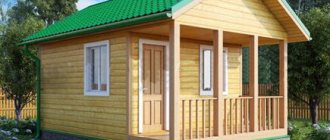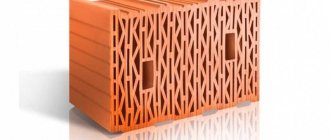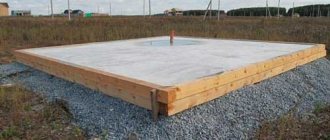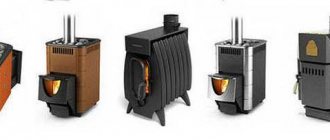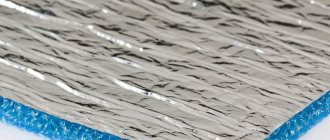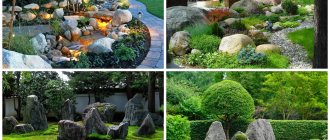For many people, a bathhouse is a whole lifestyle. The steam room has a healing effect on the body; in addition, the washing process is exciting entertainment. Therefore, we will help you figure out which bath stones are best to choose to ensure good quality steam, healing fumes and uniform heating. Read to the end and find out what properties a bath stone should have, what rocks are suitable for a steam room and how to use them.
A stove with a heater is the most important component of any sauna.
What properties should stones for a bath have?
To correctly determine which bath stones are suitable for your steam room, you should first understand the basic characteristics of these stones. They must have the following properties:
- Density. The heavier the stone, the more suitable it is for a bath or sauna.
- Heat resistance - the ability to experience systematic heating to very high temperatures.
- Heat capacity is the ability of a stone to store heat and smoothly release it into the environment. The greater the heat capacity of the rock, the longer the bath will remain heated.
- Environmentally friendly : when heated, the stone should not emit harmful substances.
- Uniformity of structure . It is not recommended to use stones with inclusions and veins in baths. Otherwise, heating will occur unevenly, which will quickly lead to destruction.
It is best to use stones with a uniform structure
- No cracks. You can check the stones by knocking them against each other. If everything is in order, the sound will be clear and clear.
There are two opinions about the size of the stones. Some people think that they should be the same size. Then the heater will heat up evenly and release heat evenly.
Others say that it is better to choose stones of different sizes. Moreover, the largest ones should be placed down, medium ones above, and small ones at the top. This is necessary so that the large lower stones store heat and retain it for a long time, releasing it a little at a time and maintaining the temperature of the rest of the heater.
There is no clear answer to the question of which stones are better for a bath, the same or different in size: both methods have proven themselves well.
Now about smooth and chipped stones. The first ones serve for a very long time, do not crack or delaminate. The latter give off heat more intensely due to their large surface area, but require frequent replacement. Here the choice is yours.
Heat exchange in crushed stones is more intense than in smooth ones
Before laying, stones can be tested for heat resistance. To do this, they need to be heated over a fire, and then immediately lowered into a bucket of cold water. If no cracks appear, then the stone will last a long time.
What is the separation of minerals and rocks
Separateness is observed in minerals and rocks. Crystals or crystal grains have the ability to break apart in certain places. This process is called detachment.
Separateness is a property that concerns not the entire mineral, but individual crystals and their structure. The separation of the rock is manifested in the form of natural cracks. During splitting, a solid slab forms separate pieces and blocks of different sizes.
There is such a classification of components:
- Layered (platy) - appears in the presence of several parallel cracks. Found in granites, limestones, dolomites, sandstones.
- Parallelepiped - formed in the presence of three conventionally mutually perpendicular crack systems. Found in granites or gabbros.
- Mattress-shaped - formed by analogy with the parallelepiped, but differs from it in the rounding of corners and edges, which are formed during weathering. It can be found in a number of igneous rocks and granites.
- Prismatic (columnar) - formed by many vertical cracks that cut the rock into prisms or pillars with five or six edges. Most often observed in volcanic rocks - basalt and others.
- Spherical (ellipsoidal) - formed when rock splits into bodies shaped like balls or ellipses, which often have a concentric shell-like structure. Can be found among tuffs and spilites.
- Polyhedral (polyhedral) - created by a complex system of cracks and breaks up into irregular polyhedra. Such separation is observed in porphyries, dolomites, sandstones, granites, etc.
Knowing the characteristics of one or another type of individuality, one can assume what forms will be formed as a result of splits.
What types of stones are suitable for a bath?
Now let's talk about which stones are suitable for use in a bath or sauna, depending on their breed. Traditionally, everyone tries to choose natural samples, the shape of which was created by nature itself.
You can also find synthetic bath stones on sale, but it is worth remembering that they do not have any healing properties.
Jadeite and its unique properties
Greenish colored stone. Of all those used for laying the heater, it is considered the most beautiful. It belongs to semi-precious rocks, so it is expensive.
Jadeite is a very beautiful stone
In addition to appearance, jadeite has other advantages:
- High heat capacity . The breed retains energy for an amazingly long time.
- Healing vapors when heated. The stone has a beneficial effect on the genitourinary and endocrine systems, and also accelerates the blood.
- Low moisture absorption. Therefore, high-quality steam is released.
Since it is too expensive to lay the entire heater with this type of stone, you can buy several copies and place them at the very top. A kilogram of jadeite will be quite enough for a medium-sized bathhouse.
Doctors say that jadeite is suitable for those with joint problems. It emits positive infrared radiation, ionizes the air and enriches water with metasilicic acid. Therefore, jadeite is suitable for those who are thinking about the question of which stones are best for a bath in a steam room for health.
The healing properties of jadeite have long been proven
The service life of this breed reaches seven years. But after five years it begins to gradually lose its effectiveness.
Crushed jadeite is more suitable for a Russian bath. Due to its large area, it produces a lot of steam. Polished stones are best used in a sauna.
Soapstone for baths and saunas
Soapstone is a beautiful and durable gray stone. It heats up quickly and accumulates heat well. A heater made of this type produces light and pleasant steam.
But for those who are thinking about which stones to choose for a bath and are considering soapstone, it is worth remembering that this is a very dusty rock. Although the problem can be solved: before laying, all stones must be thoroughly washed and dried in the sun.
The homeland of soapstone is Karelia and Finland. Therefore, it is considered a classic sauna stone.
Soapstone - a traditional stone for saunas
See also: Catalog of stone bath projects
Raspberry quartzite
When thinking about which stones are best for a sauna stove, you should pay attention to crimson quartzite. The breed has a bright brown-purple color. It stores and releases heat well and does not absorb moisture. It is considered the most crack-resistant stone. You can even pour ice water onto a hot stove lined with crimson quartzite.
Scientists know a lot about the healing properties of crimson quartzite:
- Normalizes blood pressure and strengthens the circulatory system.
- Pain relief for joints.
- Treats migraines and helps with problems associated with weather changes.
- Regulates the functioning of the reproductive system.
Crimson quartzite is a beautiful red-brown stone.
But the most important quality of raspberry quartzite or porphyry, as it is also called, for a bathhouse is that it can produce light steam for a long time, even after the stove is stopped. Therefore, washing in such a steam room is easy and pleasant.
What other stones are suitable for a bath?
When talking about which stones are best for a steam bath, you should pay attention to the following rocks:
- White quartz is a translucent stone. It looks very impressive in the heater, because when heated it creates a glow, which is why it got the name “hot ice”. However, white quartz is fragile and unstable to high temperatures, so it is better to use it in open-type heaters. Although it is an expensive stone, it will not last long.
White quartz is a beautiful but short-lived stone
- Gabbro-diabase is a durable stone that accumulates heat well. In many ways similar to soapstone. But there is a big difference in price. Gabbro-diabase is much cheaper, so it is found in many steam rooms.
Gabbro-diabase - a budget option for a bath or sauna
- Basalt is a black stone. It lasts for a very long time, most likely the heater will not have to be updated until the very end of the bath’s operation. This is due to its high density and strength, low water absorption and resistance to sudden and frequent temperature changes. In addition, it has a surprisingly high heat capacity.
Basalt is popular among all fans of the Russian bath
See also: Catalog of companies that specialize in the construction of baths and related work
- Sea pebbles. Interested in those who are wondering which stones are suitable for a steam bath, but are willing to spend a small amount on the purchase. To lay the heater, you can only take samples that have not been in contact with sea or river water for a long time. The fact is that if the stone is not sufficiently dried, then when heated it will give off an unpleasant odor. The structure of “wet” stone is also more prone to cracking.
Sea pebbles are the most affordable stone for a bath.
The heater in the steam room can also be made of such rocks as:
- Neuritis
- Jasper
- Chromite
- Dunit
- Dolerite
- Granite
Bath attendants' advice
Selecting a suitable filler is very important for bathhouse attendants, but in addition to this, stones must be able to be used correctly. It is recommended to wash and dry them before installation. For the lower layers, large fragments that retain heat for a long time are more suitable.
You can use basalt, peridotite or cast iron balls. On top are medium and small minerals with healing properties: jadeite, quartzite. The placement of stones does not require compaction, although it should be quite dense and have about 10% air gaps.
Expert opinion
Sumskikh Stas Viktorovich
Bath attendant with 10 years of experience
Honey, essential oils and other flavorings should not be added to the heater water. Otherwise, carbon deposits will begin to form on the minerals and they will smoke. To create aromatic steam, the mixture can be diluted in water, poured into a metal container and hung over the stove. Stones should be periodically inspected and cracked ones replaced.
Is it worth collecting stones for a bath?
The question of whether it is possible to collect valuable and effective rocks worries many who wonder how to choose stones for a bath. After all, this is a real opportunity to save money and at the same time create a high-quality heater.
It is quite possible to collect stones for a bath with your own hands
Most often, a stone suitable for a bath can be found on the slopes of mountains, on the shores of seas or rivers. Moreover, everything found near fresh water bodies will be of higher quality than marine samples. Although both stones were subjected to long-term processing by nature, the influence of sea water has a detrimental effect on the strength of the rock.
But when collecting stones yourself, you need to remember that many rocks can only be mined industrially. For example, gabbro-diabase, quartzite and jadeite will not lie on the surface. Therefore, manual collection implies that you will have to use only those specimens that you can find.
At the same time, there are many specialized stores that sell any breed. Here you can decide which bath stones are best to buy with unlimited choice.
Often, balanced sets with certain properties are created from stones. In this case, it is quite possible to line 80% of the heater with pebbles collected by yourself, and the remaining 20% with purchased valuable rocks.
Specialized stores offer a large selection of bath stones
FAQ
Jadeite has changed its shade. Fake?
Natural jadeite can change color when heated. This is a feature of the mineral; you should not be afraid of it. On the contrary, it is better to use the “chameleon” effect in the decor.
What is the best way to fill the heater, taking into account the cast iron base?
Polished jadeite is best suited. But due to its high cost, you can practice the following life hack: fill most of it with cheaper crushed jadeite, and lay polished jadeite on top.
How to calculate how much jadeite I will need in the oven?
The minimum furnace load is approximately half the original volume. A 100 kg stove will require 50-60 kg of stone. There will simply be no effect from a smaller load.
What size jadeite is needed for an electric furnace?
It is optimal to take stones up to 6 cm.
How to lay stones in a stove
The heating rate of the heater directly depends on the installation method. A conventional stove for a Russian bath requires gradual, uniform heating. The heating process is a long-term operation, and active steam formation will begin after all the fuel has burned out. Proper placement of stones can significantly reduce the time it takes to get the steam room into working condition.
Proper installation of the heater is the key to quick heating
The two most important characteristics of bath stones are heat capacity and thermal conductivity. It is better to place stones that are more thermally conductive, but have less heat capacity, closer to the fire. This way heat will be transferred faster from bottom to top. This rule is especially relevant when using different breeds.
It is advisable to place stones of different fractions in the heater: the smaller, the higher. After all, the larger the stone, the longer and more intensely it needs to be heated. Small stones are necessary in order to create a large heat transfer area.
Smaller stones should be placed on top
Important Features
As mentioned above, sauna stones must be environmentally friendly, homogeneous and solid. For uniform heating, you should choose rocks of the same size. There are a number of other points that are worth paying attention to:
- absence of white spots on the surface that can be scratched with a fingernail;
- absence of small fibers (asbestos);
- purity of the material.
It doesn't matter whether the stones were collected yourself or bought in a store. Before laying them out, they must be thoroughly rinsed with water, even if they seem clean.
Which stone is better for a bath: chipped or polished? It all depends on individual preferences. The former, according to experienced bathhouse attendants, have a larger area of contact with water, which means more steam is generated. The second option takes longer to warm up, but provides better circulation of warm air in the sauna.
Types of stones for baths (video)
The best stones for a bath in terms of durability
Different breeds differ in durability. Not every stone can withstand a large number of heating and cooling cycles. Since, being in a steam room, many people prefer to pour water on the hot stones for better steam release. Such exposure may have a negative impact on them.
Which bath stones are better in terms of durability:
- nephritis (up to 10 years);
- porcelain (up to 10 years);
- cast iron (up to 6 years);
- dunit (up to 6 years).
Proper care of bath stones
Even natural stone, a seemingly very strong and durable material, becomes unusable after some time of use in extreme bath conditions. Over the course of a year, the heat output of the furnace can decrease by 15-20%.
Due to the constant high temperature, bath stones quickly lose important properties
It is recommended to carry out a complete inspection of the entire heater at least once a year. Damage, chips, cracks are a signal. That the stone needs to be changed. After inspection, it is advisable to rinse everything with clean running water. Every two years it is worthwhile to completely replace all the stones, however, if the sauna is used relatively rarely, then the service life can reach five years.
Video description
Here is an interesting video on how to wash stones for a bath:
In order for the steam room to function normally, it is necessary to correctly calculate the mass of the stones. It is believed that there should be 5-6 kg of rock per square meter. Then the desired effect and maximum durability of the heater will be achieved.
Different types of stone differ in their service life
For stoves with a closed heater, a type that is more resistant to high temperatures is needed. In open stoves, the heating is less intense, so deciding which stones are better for the heater in the bathhouse is much easier.
Types
Jadeite in industry is divided into different types.
Based on color
Albite (jad-albite)
- thick green color;
- pronounced black inclusions and spots.
Utility
- uniform bright green color;
- opaque surface.
Chloromelanite
- green color of rich tones;
- small dark inclusions.
Commercial
- dense green color;
- the bulk is not transparent;
- admixtures of emerald undertone;
- translucent veins.
Imperial
- emerald color;
- transparent or translucent;
- fine-grained or homogeneous.
For steam, Utility is best suited. Imperial is completely jewelry. The rest can completely complement each other in baths on decorative elements.
By invoice
Chipped
- large area of specimens;
- many natural irregularities;
- pronounced edges.
Sanded
- smooth;
- brilliant;
- Available in different sizes.
Bounded
- processed from unevenness;
- has no impurities.
The crushed one gives off steam well, but the rolled one is more resistant to mechanical stress, so it will last longer. Polished specimens are the most beautiful and durable, but they are so expensive that they are most often used to highlight individual areas, the top layer of the heater.
In shape it can be small pebbles or impressive bricks, tiles, a scattering of small pieces, figurines and all kinds of blocks.

